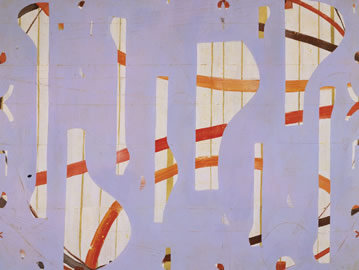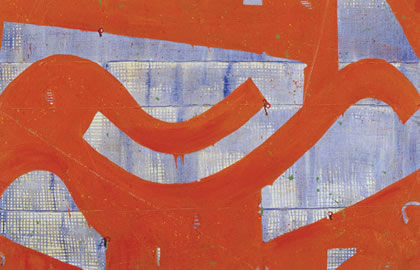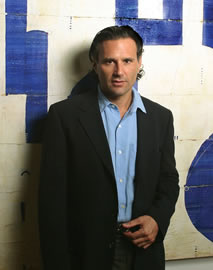|
Verbatim
An
Artist’sWay
In Vanity Fair's recent profile of painter
Caio Fonseca, his brother-in-law, writer
Martin Amis aptly described the artistic
Fonseca family as “glamorous in the old,
true sense—very beautiful and equally
talented.” Fonseca is a classically trained
pianist who speaks French, Spanish and
Italian.
Having spent his 20's in Europe
intensively studying his craft, training for
five years in Spain with Augusto Torres,
son of Joaquin Torres-Garcia, a pioneer of
modernism, Fonsceca now splits his time
between Italy and New York City.
His paintings are displayed in New York's
Whitney and Metropolitan museums as
well as in the Smithsonian and the Houston
Museum of Fine Art. On the eve of the
opening of his first solo exhibition in the
United States at the Corcoran Gallery of
Art (on exhibit until February 14), Caio
Fonseca sat down with Washington Life's
editor in chief, Nancy Bagley to talk about
his life and his work.
Washington Life: What is your artistic process? Do you visualize or conceptualize a painting before
you begin, or do you prepare the foundation and let
it lead to where each layer takes you?
Caio Fonseca: To break it down to the practical,
it involves things as simple as deciding on the size
of the painting and beginning to draw. What’s
most curious about the way that I work is that I
begin putting down a color composition of related
material and then work backwards covering it in a
layering process in order to leave behind forms. I
have to add something to subtract it, and in the first
half of the work, I lay down the potential that a
future painting might have to draw from in the second
phase. It’s almost like the cliché of a sculptor
eliminating stones to find the piece.
 |
WL: What do you want to impress upon people
through your art?
CF: I’ve chosen to speak with paint and not writing,
not film, nor German, ect. What I have to say
is very idiomatic to the potential of paint to speak
in its own language. If I play a Bach piece for
someone they might like it but they would never
say, “That was beautiful but what does it mean?”
We seem to agree that music is capable of speaking
for itself and a helpful invitation to my work might
be to allow yourself to listen to the painting in that
way.
WL: You come from a family of artists, so it seems
almost pre-determined that you would express
yourself creatively. If you were not an artist or a
musician, what do you think you would be?
CF: That’s unfair to eliminate those two possibilities.
What else might I have become? I would have
to be a different person because I am a strange
combination. I can function in the real world but I
am much happier out of it. So, it’s hard to say what
I would be and still be me. Hmm, mid-level management
comes to mind. [laughs]
WL: How did your father, a sculptor, influence
your work?
CF: My father had the wisdom not to teach us
directly. Father, son, and master are all very different
relationships. My father is such a towering
example of integrity, which was a benevolent form
of pressure that my brother and I both felt. I think
my father’s abhorrence of mediocrity was a great
sort of fuel. He used to say, “If you strive to be
excellent, you’ll be very good. If you strive to be
very good, you will be poor” and so on. He was
also an example of what an artist’s life is like on
a day-to-day basis, so it was not alien to us. Our
father was the kind of artist that for the last ten
years of his life checked out from even exhibiting,
[because] he said he wanted time. I have the
privilege of arranging a massive retrospective of his
work at the Houston Museum of Fine Arts in a few
years. He was a supreme artist and you will hear
about him in due course.
WL: How has sculpture affected your painting?
CF: I’ve done sculpture and worked with all kinds
of stone and wood, [but] I am firmly convinced that
I feel the two dimensions of painting, even with all
its ambiguity and spatial relationships. Nothing I
can do in sculpture would supersede what I want
to do with painting, except for that interesting relationship
of removing things. And maybe that is the
link between my painting and sculpture.
WL: You said your father has a lot of integrity.
What is integrity to you?
CF: Integrity is following your work to its ultimate
limits. In his case, I use the word integrity because
he abandoned everything else for that cause,
including the quest for renown and all other goals.
It’s also the quality of the work, the difficulty of
executing it and the physical integrity of exertion
and living alone on a hilltop.
WL: It seems Pietrasanta, Itlay, where you
spend half the year painting, is a refuge for
you--- solitude away from the commercial
and frenetic world of New York. What is
it about Tuscany that inspires you, and do
you see a difference in the work that you
complete in Italy from the paintings you do
in New York?
CF: Well, I’ve been going to Italy for
twenty years [consecutively] I love being
in a small town as an antidote to the big
town of New York and I’m not so interested
in the middle ground. The phone
doesn’t ring, which is a luxury. And to have
four or five consecutive months of studio
time is inimitable. I’m an all or nothing
person, so much so that I can’t handle mundane
details in the morning and do my best
work in the afternoon. I can do either but
I can’t do them together. I used to say that
my work from Italy is no different from
New York, but I think inevitably palette
and mood creep into the painting, but not
dramatically.
WL: What have you learned in Europe that
you couldn’t learn here?
CF: I was away from my country and my
language for such a long period of time.
[from age 19 to 32 years old] [But] it gave
me an incubator to study in, and I think it
unburdened me from the need to be original
and the self-inflicted pressure to exhibit
immediately and have something neo or
post or some statement to make at 21 years old. I
don’t see how that [pressure] isn’t an inhibition to
learning who you are.
I think you have to form yourself as much as
possible in your early years.
 |
WL: You once said, “Ultimately our work is to
understand ourselves.” And that you are the kind
of person who likes to look under the surface.
What have you learned about yourself through your
painting that you did not know a year ago or five
years ago?
CF: One thing I have learned is that I am not trying
to express Caio Fonseca, and how I am feeling, as
many artists legitimately do. Ultimately, our goal
is to understand ourselves, not just our personalities,
but the very nature of form and the complex
set of circumstances that make up an individual. I
compare it to a young painter confronted with a still
life, it’s such a complex plethora of visual information
and shadows. But over many years, you begin
to understand and reduce these things to irreducible
elements, if that makes any sense. Then try to
imagine it projected on to an individual with all its
complexities, and you begin to learn what is essential.
In the last 26 years, I have learned that it’s not
just about becoming a better painter, but it has to
do with understanding the nature of a human being.
Painting is a vehicle for understanding the nature of
forms of which we are one.
WL: Why is now the right time for your first
national museum show in the United States?
CF: The timing was right a few years ago but they
didn’t call me… no, just kidding. I think events
like a Corcoran opening make you understand
milestones with a certain hindsight and the things
you think should come earlier you realize came at
just the right time. It’s a miracle that events like
a museum taking interest should occur when I
believe I’m at a very strong moment in my work.
WL: If you could have any painting in the world… which one would it be?
CF: Hmmm…I’m gonna have to get back to you
on that. The cheap answer would be I’d love to
own the painting I’m trying to paint. That belongs
in a Hallmark card.
WL: When you view other artists’ work what qualities
do you most enjoy?
CF: Other living artists?
WL: Living or not.
CF: Well, the living ones, I most like the
fact that they are living— their breath
of life. No, seriously it’s rare for me to
embrace the whole work of an artist. In
some artists, I admire a sense of proportion,
in others, a sense of color.
WL: What are the qualities you most
admire in yourself?
CF: When I was a kid and there was a
block of ice on the street— I kicked it
once and then I kicked it again and it got
smaller. Then I just decided I was going
to kick it until it disappeared. I always
remembered that, I don’t know why? I
think one quality that has been a great aid
to me is that when I decide something I
stick with it and I pursue it to its conclusion.
WL: Is that stubbornness or conviction?
CF: No, I don’t have a Bush-istic stubbornness.
[laughs] The minor quality of
mine that I most enjoy, is turning a dull
situation, seeing the humor in it and just
skirting the border of inappropriateness
without ever, ever going beyond it.
WL: What qualities do you most admire in
others?
CF: Mental agility, with a pinch of goodness,
humor and smarts. Throw that
together and...
WL: How do you measure success?
CF: There are different ways of answering the
question but to me the whole question about success
revolves around how successful the work is.
Just recently, I began thinking about this, as my
work goes out into the world— divorced from my
personality. I think the kind of success that I’m
after might be in a painting’s autonomy, and its
ability to speak for itself. I am more ambitious
for my work than for myself. The more mundane
forms of success and notoriety can all be enjoyed
in their just place. But you better be in very good
health artistically. When I come back from a few
months in Italy, I can enjoy and handle a couple
months of all this stuff. So I would say that success
for me would be that the painting speaks for itself.
Then the painter can stop talking. |



